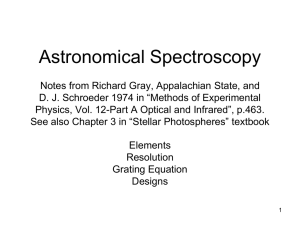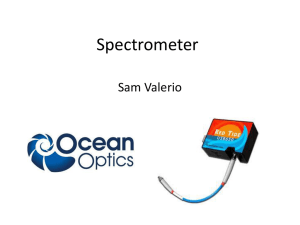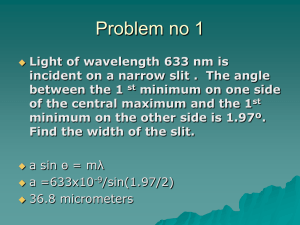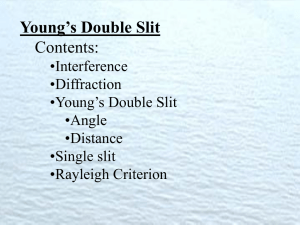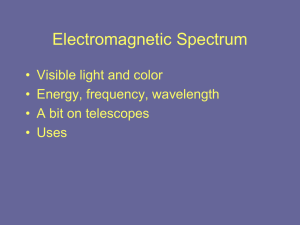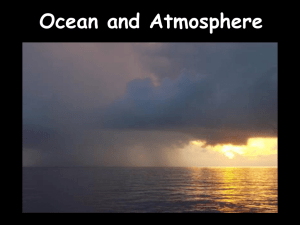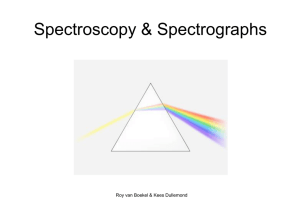Lecture 6-Spectral resolution, wavelength coverage, the atmosphere
advertisement
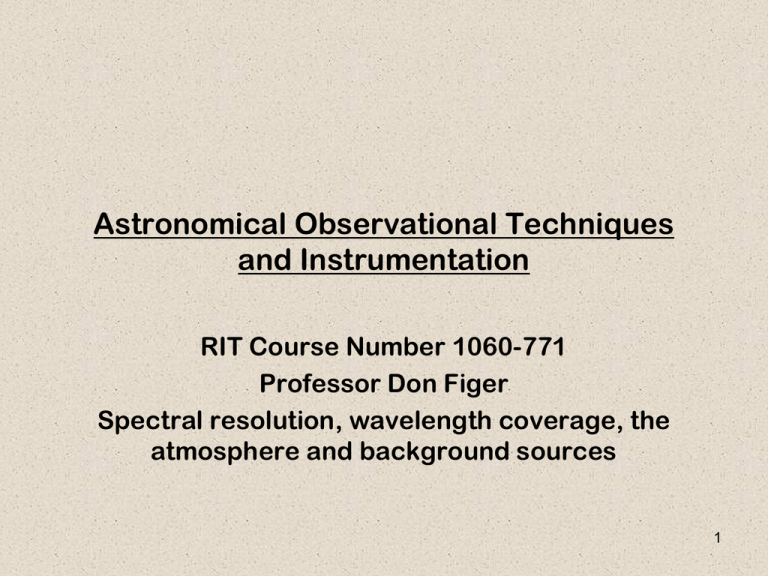
Astronomical Observational Techniques
and Instrumentation
RIT Course Number 1060-771
Professor Don Figer
Spectral resolution, wavelength coverage, the
atmosphere and background sources
1
Aims and outline for this lecture
• describe system requirements for spectral resolution and
wavelength coverage
• describe atmospheric effects on observations
• summarize primary background sources and effects on
observations
2
Need for Spectral Information
•
•
•
•
“A picture is worth a thousand words.” --Barnard
“A spectrum is worth a thousand pictures.” --an astronomer
A spectrum is the distribution of flux versus wavelength.
Spectra are critical for making measurements of physical
properties of astronomical objects.
– low resolution spectra reveals spectral energy distribution (SED)
– high resolution spectra reveals emission/absorption features
3
Spectrum of Arcturus
4
High Resolution Spectroscopy
• High resolution spectroscopy can yield
–
–
–
–
–
–
–
–
velocity
abundances
temperature
virial mass (through integrated light)
molecular excitation
interstellar absorption
ionization state
others
• The example on the right shows high
resolution infrared spectra of red
supergiants.
• Note the many CO rotational-vibrational
absorption lines.
• The slight translations in the wavelength
axis from star to star shows velocity
differences.
• Weaker features to the left reflect atomic
absorption and can be used for
abundance analysis.
velocity difference
CO bandhead
atomic absorption
5
Low Resolution Spectroscopy
• Low resolution spectroscopy can yield
–
–
–
–
emission mechanism (via spectral index)
temperature
molecular content
interstellar molecular absorption
• The example on the right shows low
resolution infrared spectra of red
supergiants.
• Note the CO bandhead.
• The depth of the bandhead indicates that
these stars are cool.
• For this application, it might be just as
well to obtain a high resolution spectrum
over this waveband.
• In some cases, a low resolution spectrum
can reveal curvature over a broad range
of wavelengths – something difficult to
detect in high resolution spectra.
CO bandhead
6
Spectrograph/spectrometer
• A spectrograph/spectrometer is an instrument that can measure intensity
versus wavelength.
– dispersive
• prism
• grating
– nondispersive
• filters, circular variable filter (CVF)
• Fabry-Perot
7
Spectroscopy System Design Criteria
• Efficiency: amount of light directed into the spectrum
• Resolution: minimum spatial and spectral separation between
resolved features
• Scattering: light directed out of the spectrum or in undesired
locations in the spectrum
• Stability and calibration accuracy: ability of system to
maintain or reproduce wavelength versus pixel relationship
• Background: light from all sources other than target, might be
sky, telescope, optics, baffles, etc.
• Packaging: compactness of layout
8
Spectrograph Cartoon
9
Continuum and Emission Lines
10
Absorption Lines
11
Equivalent Width
• Equivalent width is a measure of flux in a line.
• It is independent of instrument parameters.
12
Spectroscopy System Design Form Example
• graphic shows simple layout for spectrograph
grating normal
telescope
detector
lens
slit
collimator
grating
13
Spectral Resolution
• Spectral resolution is a measure of the ability to separate
nearby features in wavelength space.
R
, minimum wavelengt h separation of two resolved features.
• Delta lambda
–
–
–
–
often set to the full-width at half-maximum of an unresolved line
can be measured in the data
depends on data analysis
can be limited by diffraction, slit width, detector sampling
14
Spectral Resolution: Prism
• A prism disperses light with a transmissive optic that has
chromatic index of refraction.
15
Gratings: Grating Equation
• The grating equation gives the geometry for constructive
interference between facets of a grating. The equation can be
derived by setting the optical path difference between light
scattering from two adjacent facets to an integer multiple of
the wavelength.
opticalpathdifference d sin out d sin in m
• In more standard nomenclature,
mT sin sin
where, m is the order number and T is the groove density.
• Note that the equation reduces to the law of reflection for m=0.
16
Gratings: Angular Resolution
• Angular resolution describes the variation in output angle
versus wavelength. It can be found by differentiating the
grating equation.
d
mT
cos
d
d
mT
sin sin Littrow 2 tan
d cos
cos
• Note that the angular resolution can be increased by increasing
the output angle.
• For a fixed wavelength, angular resolution is dependent on 17
geometry.
Gratings: Diffraction-limited Resolution
• The diffraction-limited resolution of a grating is simply Nm,
where N is the number of illuminated grooves and m is the
order number.
18
Gratings: Slit-limited Resolution
• The resolution, or resolving power, is usually limited by slit
width. (“primed” quantity is at image plane)
R
slit
sin sin
R
((xslit Fcam / Fcoll ) / Fcam ) cos
R
slit (d / d )
sin sin
R
cos xslit / Fcoll
R
(xslit / Fcam )(d / d )
Fcoll (sin sin )
R
cos xslit
2 Fcoll tan 2 Dcoll tan
(sin sin ) /(m T)
Littrow
R
R
(xslit / Fcam )(cos /(m T))
xslit
Dtele slit
19
Gratings: Diffraction-limited Image
• Imagine that we set the slit width to be equal to the full width
at half maximum of a diffraction-limited spot. (Assume
Littrow).
2 Fcoll tan
2 Dcoll f coll tan
2 Dcoll tan
R
Ftele (1.22 / Dtele ) Ftele (1.22 / Dtele )
1.22
• Note that the resolution can be increased by increasing the size
of the collimated beam (and size of grating), increasing the
output angle, or decreasing the wavelength (assuming that the
decrease in wavelength is accommodated by a decrease in the
spot size and decrease in slit width).
20
Gratings: Increasing Resolution
• From the previous equations, it appears that resolution can be increased by:
– decreasing the slit width (which might decrease the transmitted flux)
– increase the collimator focal length (which will increase the beam size and
required size of the grating)
– increase the output angle (which will increase the required size of the grating)
• There is another possibility that is not apparent from the grating equation,
given that its derivation assumed that the index of refraction of the material
surrounding the grating was one.
• A more general derivation would show that the realized angular dispersion
is multiplied by n.
– This effect is used in an immersion grating
– Silicon is a particularly useful material for this purpose because it has a high
index (n~4), although it is only transmissive in the infrared.
21
Gratings: Immersion Grating Resolution
• The resolution can be increased by immersing the grating
surface in a high index material.
mT n(sin sin )
mT
sin sin Littrow
d
d
2 tan
n
n
n
n
d
d
n
cos
cos
• Note that angular dispersion is n times greater than for case
without immersion.
22
Gratings: Echelle Grating
• Angular dispersion is dramatically increased when using an
“echelle” grating.
• In this case, the output angle is typically >60 degrees.
• Because an echelle is used at a large angle, it must be
rectangular.
• The grating facets must be ruled at a large angle, because:
– In order to maintain high efficiency, the input and output angles should
be the same (“Littrow condition”).
– In order to provide high resolution, the output angle must be large.
23
Gratings: Echellogram
+
+
HIRES order format showing the solar spectrum
(note that color was artificially added for illustrative purposes)
24
Gratings: Immersion Grating
25
Fabry-Perot Etalon
• A Fabry-Perot etalon is a filter that selectively transmits a
narrow range of wavelengths.
• Like a thin film, it transmits the most flux at wavelengths that
satisfy the thin film condition.
• Finesse is a function of reflectivity.
2nt
,
m
where, n index of refraction, m order number and t thickness.
max
26
Wavelength Coverage: Free Spectral Range
• Multiple orders of the same wavelength range are dispersed to
either side of the order of interest.
• The non-overlapping wavelength region in the order of interest
is defined as the “free spectral range.” Outside of this range,
light of different wavelengths in multiple orders overlap.
1
order=m
1
m-1
2
2
m
m+1
FSR
overlap
overlap
• FSR=/m
27
Atmospheric effects
• Absorption
– reduced flux from source
– difficult calibrations
• Emission
– increased background noise
– reduced integration times
– difficult calibrations (subtracting time-varying components)
• Turbulence
– increased object size (“seeing”)
• All effects vary with wavelength, time, altitude, line-of-sight
28
Atmospheric absorption
• Molecules are the dominant absorbers (H2O, CO2, Ox)
• Strong function of:
–
–
–
–
wavelength, atmospheric wavebands
time, frequent calibration (hour timescales)
altitude, mountain-top observing sites
line-of-sight, limited target access and frequent calibration
29
Atmospheric absorption versus
• Sharp cutoffs
– defined primarily by H2O
– shape wavebands
• Higher transmission between lines with higher resolution
• Can introduce large calibration errors for low resolution observations
(MNRAS, 1994, 266, 497)
30
Wavelength Regimes: near/mid-infrared:
Atmospheric Transmission
Atmospheric Transmission: near/mid-infrared
1.00
0.90
0.80
Transmission
0.70
0.60
0.50
0.40
0.30
0.20
0.10
0.00
0
5
10
15
20
Wavelength (microns)
25
30
35
31
Wavelength Regimes: near-infrared: Atmospheric
Transmission
Atmospheric Transmission: near-infrared
1.00
0.90
0.80
Transmission
0.70
J
0.60
H
K
L
M
0.50
0.40
0.30
0.20
0.10
0.00
1
1.5
2
2.5
3
3.5
Wavelength (microns)
4
4.5
5
5.5
32
Atmospheric absorption versus - high res
Array defects
CO2 absorption lines
R = / ~ 23,000
+
+
Keck II 10-m
33
Atmospheric absorption versus altitude
• Particle number densities (n) for most absorbers fall off rapidly with
increasing altitude.
I I 0, e , where τ λ is optical depth,
ndx e x / x dx.
0
• Density of atmospheric constituents modeled as exponential.
• x0,H20 ~ 2 km, x0,CO2 ~ 7 km, x0,O3 ~ 1530 km
• So, 95% of atmospheric water vapor is below the altitude of Mauna Kea.
34
Atmospheric absorption versus airmass
• The amount of absorbed radiation depends upon the number of
absorbers along the line of sight
AM=1
Atmosphere
I I 0, 10
mag / 2.5
AM=2
, mag AM ,
where χ is atm. extinction coefficient.
35
Atmospheric emission
• Blackbody (thermal)
• Molecular (OH)
36
Thermal emission
spectral radiance, brightness, specific
intensity:
In = e cos Bn(T) W m-2 Hz-1 sr-1
e emissivity (dimensionless)
Planck (blackbody) function:
2hn3
1
Bn(T) =
c2 exp(hn/kT) - 1
B(T) =
2hc2
5
1
exp(hc/kT) - 1
Peak in nBn or B:
3674 K
max(mm) =
T
max~10 mm for room
temp.
37
Atmospheric emission: Blackbody
Total power onto a detector:
P = h AW n esky Bn(Tsky)
h:
transmission of all optics x Q.E.
esky: emissivity of sky
A:
telescope area
W:
solid angle subtended by focal plane
aperture
n:
bandwidth
Bn(Tsky): Planck function
At 10 mm, typically: h ~ 0.2, e ~ 0.1, AW ~ 3x10-10 m2 Sr
n ~ 1.5 x 1013 Hz (10 mm filter), T ~ 270 K
P ~ 10-9 W or ~ 4 x 1010 g s-1
38
Atmospheric emission: A Note on Solid Angle
• Background from the sky can be calculated by multiplying the
blackbody equation by the area of the sky seen by the detector
and the solid angle subtended by the telescope aperture.
Flux h Asky Wtelescope n e sky Bn (Tsky ).
• The AW product is invariant in a system.
Asky Wtelescope AtelescopeWsky .
1
Asky
0
Atelescope
detector
x
d
D
d
A sky W telescope x
F
2
F
2 2
2
2
nˆ dA d 0 d 2 sin dd d
d2 2
d 2 2 ( D / 2) 2
xD
x 2 (1 cos 0 ) ~ 2 x 0 2 x
.
d 2 F x 0 0
d2
F
F
d2
F
2F
x / 2 xD .
D 21d
D212 D2
2
d
F2
2
2F
2
A telescopeWsky
2
2
2
• It is easier to use area of telescope and solid angle of sky.
39
Atmospheric emission: OH lines
Photons s-1 m-2 asec-2 mm-1
OH lines
Wavelength {mm}
40
Atmospheric emission: Molecular lines
Array defects
OH lines
R = / ~ 23,000
+
+
Keck II 10-m
41
Atmospheric emission versus time
42
Atmospheric Turbulence
• Static atmosphere bends light (n=1.000273 at 2 mm)
• Dynamic atmosphere distorts the wavefront
Orionis (“Betelguese”)
Data from the William Herschel 4.2 metre
Telescope in La Palma. Wavelength 689.3nm,
Exposure time 30ms per frame. The data were
taken with a simple Speckle Camera situated on
the GHRIL platform of the telescope. The data
sets were taken with the Speckle Imaging group
at Cardiff University.
43
Atmospheric Turbulence
• A diffraction-limited point spread function (PSF) has a full-width at
half-maximum (FWHM) of:
{m}
{mm}
FWHM 1.2
{radians} 0.25
{"}.
D{m}
D{m}
• In reality, atmospheric turbulence smears the image:
{mm}
6/5
FWHM 0.25
{"}, where r0 .
r0 {m}
• At Mauna Kea, r0=0.2 m at 0.5 mm.
• “Isoplanatic patch” is area on sky over which phase is relatively
constant.
44
Lick 3-m (1994)
45
Keck 10-m (1997)
46
HST/NICMOS (1997)
47
VLT/AO (2002)
48
Keck/LGSAO (2006)
49
Background - sources
• Atmosphere
– thermal
– molecular
• Telescope
– thermal
– scattering
• Zodiacal light
• Astronomical sources
50
Background - sources: Atmosphere
• Thermal
• OH
n
C sky,thermal h instrh tele AW e sky Bn (Tsky )QE {e s 1}
hn
– The average OH line intensity is approximately 25,000 g s-1
m-2 asec-2 mm-1. See Maihara et al. 1993.
– The continuum between lines is about 50 times lower than
this value (in the H band).
51
Background - sources: Telescope - scattering
• Mirrors
2
s
I scattered , where s is RMS deviation
from a perfect surface.
• Baffle edges and walls
• Secondary support
52
Background - sources: Astronomical
• Astronomical objects can be objects of interest or
noise contributors, depending on the project.
–
–
–
–
–
Sunlight, moonlight
Light scattered by solar system dust (“zodiacal”)
Light emitted (thermal) by solar system dust (“zodiacal”)
Stars (especially in a crowded field)
Light emitted by interstellar dust (“cirrus”)
53
Background - sources: Astronomical
54
Background - sources: COBE data
55
Background and Signal-to-Noise Ratio
• Recall the expression for SNR.
S
N
S
N
2
i
.
i
• The noise is the quadrature sum of uncorrelated noise sources.
N total N
2
read
N
2
dark
N
2
source
N
2
back
• Background noise is the quadrature sum of shot noise for each
background source.
2
2
2
2
2
2
N back
N sky
N
N
N
N
,OH
sky ,thermal
tele ,thermal
zodi
other .
56
